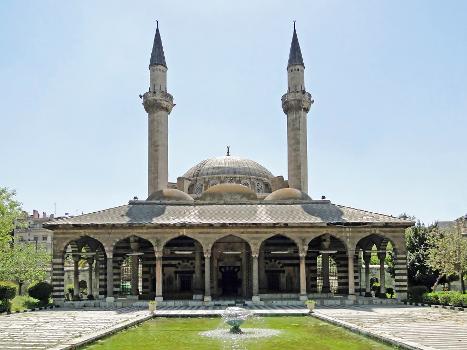General Information
Project Type
Location
Technical Information
Dimensions
| number of minarets | 2 |
Excerpt from Wikipedia
The Tekkiye Mosque or Sultan Selim Mosque (Arabic: التكية السليمانية, Turkish:Selimiye Camii or Sultan Selim Camii) is a mosque complex in Damascus, Syria, located on the banks of the Barada River.
Construction
The Sultan of the Ottoman Empire, Selim II, built the Sultan Selim Mosque in the then-suburb of Damascus by expanding his father's (Suleiman I) urban complex. The complex is composed of a large mosque on the southwest side of a courtyard, flanked by a single line of arcaded cells, and a soup kitchen across the courtyard to the northwest, flanked by hospice buildings. The mosque has two minarets and walls with alternating light and dark stripes. It has been described as "The finest example of Ottoman architecture in Damascus".
Cemetery
The cemetery next to the mosque is the burial place of the last Ottoman Sultan, Mehmet VI, who was dethroned and forced into exile when the Ottoman sultanate was abolished in 1922. He died on May 16, 1926 in Sanremo, Italy and was buried at the cemetery of the Sultan Selim Mosque. The mosque was chosen because it was located in the closest Muslim-majority country to Turkey and was built by his ancestors. There are almost thirty other graves of the Ottoman dynasty who died in exile and were not allowed to be buried in the Republic of Turkey at the time.
Text imported from Wikipedia article "Tekkiye Mosque" and modified on July 23, 2019 according to the CC-BY-SA 4.0 International license.
Participants
- Mimar Sinan (architect)
Relevant Web Sites
Relevant Publications
- (2010): Seismic vulnerability of historical masonry buildings for different earthquake characteristics: Case study of the mosque of Takiyya al-Sulaymaniyya. In: Mauerwerk, v. 14, n. 3 (June 2010), pp. 143-149.
- About this
data sheet - Structure-ID
20046303 - Published on:
31/07/2009 - Last updated on:
20/06/2023






